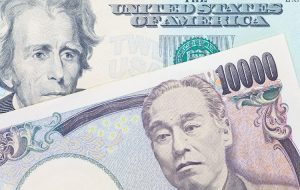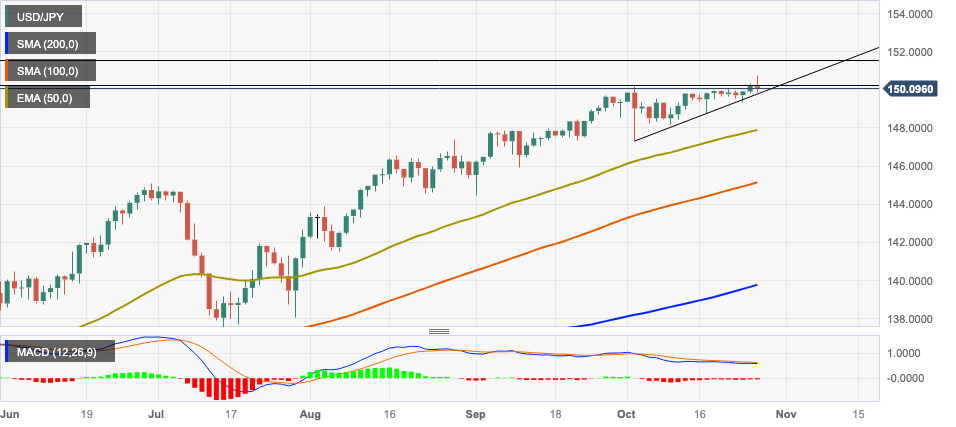Japanese Yen cannot keep up with Greenback as pair rises to 150.42
[ad_1] Share: Japanese Yen declines against the US Dollar due to broad risk aversion on Israel-Palestine tensions. FX market intervention from the Japanese authorities may have propped up the weakening Yen as USD/JPY passed the 150 threshold. In the US session, USD weakens after a raft of US data releases, including GDP and

[ad_1]
- Japanese Yen declines against the US Dollar due to broad risk aversion on Israel-Palestine tensions.
- FX market intervention from the Japanese authorities may have propped up the weakening Yen as USD/JPY passed the 150 threshold.
- In the US session, USD weakens after a raft of US data releases, including GDP and Jobless Claims.
The Japanese Yen (JPY) continues to lose out against the Greenback on Thursday, with the the pair rising about 30 basis points to 150.42 at the time of writing. USD/JPY yo-yos in a wide range versus the US Dollar (USD) as numerous factors impact the pair, from increasing tensions on the Gaza strip to the release of key US data and the rumored intervention of Japanese authorities in the FX markets.
The Yen weakened initially versus the USD, which benefited from safe-haven flows and higher US yields. JPY was later supported by probable intervention from the Japanese Ministry of Finance (MoF) after the USD/JPY rate crossed the 150 defensive line – a level traditionally defended by the MoF.
US data on Thursday shows an unexpected rise in America’s GDP to 4.9% in Q3 on an annualized basis, solidly beating consensus estimates of 4.2%. US Durable Goods Orders rose 4.7% versus estimates of 1.5% and Initial Jobless Claims increased to 210K versus 208K expected. Despite being mostly positive, the data fails to help the Dollar, and the US Dollar Index (DXY) registers a drop after the data, with DXY down a 10th of a percentage point just over an hour after the releases.
Daily digest market movers: Japanese Yen
- The Japanese Yen weakens versus USD on Thursday amid increased risk aversion due to intensifying Middle East tensions.
- The US Dollar also finds support from a rise in the highly-correlated US 10-year Treasury yield, which reaches to within a hair’s breadth of 5.00%, as a result of improving US business activity data.
- The USD/JPY pair briefly shoots to 150.80 in the early European session but then abruptly reverses, possibly as a result of Japanese MoF intervention.
- USD/JPY then encounters further volatility after the release of US data showing unexpected rises in GDP and US Durable Goods Orders.
- Initial Jobless Claims rise more than expected to 210K but the figure is still at historic lows.
- The yield on the 10-year Japanese Government Bond (JGB) also rises again to trade at 0.885% on Thursday. This is closer to the Bank of Japan’s Yield Curve Control (YCC) threshold of 1.0%, which if touched will likely lead to the BoJ implementing further easing. This will probably have a negative impact on the Yen but be bullish for USD/JPY.
Japanese Yen technical analysis: Breaking above 150 but lacking momentum
USD/JPY has broken above the key 150 psychological level on Thursday as the overall uptrend extends. The pair is bullish on a long-term, intermediate and short-term basis.
The uptrend is biased to continue given the absence of reversal signs and the next major target is at the 152.00 highs achieved in October 2022.
The pair has completed what appears to be an ascending triangle on the daily chart and broken above the 150.16 highs of October 3, confirming a breakout. Although it has not been a particularly decisive breakout – Thursday’s breakout candle is a ‘Doji’ indicating indecision – price will, nevertheless, probably continue higher, given the overarching uptrend. The triangle’s technical target is at around 152.

US Dollar vs Japanese Yen: Daily Chart
The Moving Average Convergence Divergence (MACD) momentum indicator is showing bearish divergence with price when compared with the October 3 high. This happens when price makes a higher high, but momentum fails to follow suit. This is indicative of underlying weakness in the upmove. This nuances the bullish analysis and increases the risk the triangle breakout may be ‘false’.
A re-break above Thursday’s highs of 150.80 would provide fresh confirmation of the continued advance.
Triangles are sometimes the penultimate formations in a trend, suggesting the chance the current uptrend may be getting near to its culmination point.
US Dollar FAQs
The US Dollar (USD) is the official currency of the United States of America, and the ‘de facto’ currency of a significant number of other countries where it is found in circulation alongside local notes. It is the most heavily traded currency in the world, accounting for over 88% of all global foreign exchange turnover, or an average of $6.6 trillion in transactions per day, according to data from 2022.
Following the second world war, the USD took over from the British Pound as the world’s reserve currency. For most of its history, the US Dollar was backed by Gold, until the Bretton Woods Agreement in 1971 when the Gold Standard went away.
The most important single factor impacting on the value of the US Dollar is monetary policy, which is shaped by the Federal Reserve (Fed). The Fed has two mandates: to achieve price stability (control inflation) and foster full employment. Its primary tool to achieve these two goals is by adjusting interest rates.
When prices are rising too quickly and inflation is above the Fed’s 2% target, the Fed will raise rates, which helps the USD value. When inflation falls below 2% or the Unemployment Rate is too high, the Fed may lower interest rates, which weighs on the Greenback.
In extreme situations, the Federal Reserve can also print more Dollars and enact quantitative easing (QE). QE is the process by which the Fed substantially increases the flow of credit in a stuck financial system.
It is a non-standard policy measure used when credit has dried up because banks will not lend to each other (out of the fear of counterparty default). It is a last resort when simply lowering interest rates is unlikely to achieve the necessary result. It was the Fed’s weapon of choice to combat the credit crunch that occurred during the Great Financial Crisis in 2008. It involves the Fed printing more Dollars and using them to buy US government bonds predominantly from financial institutions. QE usually leads to a weaker US Dollar.
Quantitative tightening (QT) is the reverse process whereby the Federal Reserve stops buying bonds from financial institutions and does not reinvest the principal from the bonds it holds maturing in new purchases. It is usually positive for the US Dollar.
[ad_2]
لینک منبع : هوشمند نیوز
 آموزش مجازی مدیریت عالی حرفه ای کسب و کار Post DBA آموزش مجازی مدیریت عالی حرفه ای کسب و کار Post DBA+ مدرک معتبر قابل ترجمه رسمی با مهر دادگستری و وزارت امور خارجه |  آموزش مجازی مدیریت عالی و حرفه ای کسب و کار DBA آموزش مجازی مدیریت عالی و حرفه ای کسب و کار DBA+ مدرک معتبر قابل ترجمه رسمی با مهر دادگستری و وزارت امور خارجه |  آموزش مجازی مدیریت کسب و کار MBA آموزش مجازی مدیریت کسب و کار MBA+ مدرک معتبر قابل ترجمه رسمی با مهر دادگستری و وزارت امور خارجه |
 مدیریت حرفه ای کافی شاپ |  حقوقدان خبره |  سرآشپز حرفه ای |
 آموزش مجازی تعمیرات موبایل آموزش مجازی تعمیرات موبایل |  آموزش مجازی ICDL مهارت های رایانه کار درجه یک و دو |  آموزش مجازی کارشناس معاملات املاک_ مشاور املاک آموزش مجازی کارشناس معاملات املاک_ مشاور املاک |
برچسب ها :Fundamental Analysis ، Greenback ، Japanese ، Pair ، Rises ، Technical analysis ، USDJPY ، Yen
- نظرات ارسال شده توسط شما، پس از تایید توسط مدیران سایت منتشر خواهد شد.
- نظراتی که حاوی تهمت یا افترا باشد منتشر نخواهد شد.
- نظراتی که به غیر از زبان فارسی یا غیر مرتبط با خبر باشد منتشر نخواهد شد.





ارسال نظر شما
مجموع نظرات : 0 در انتظار بررسی : 0 انتشار یافته : ۰